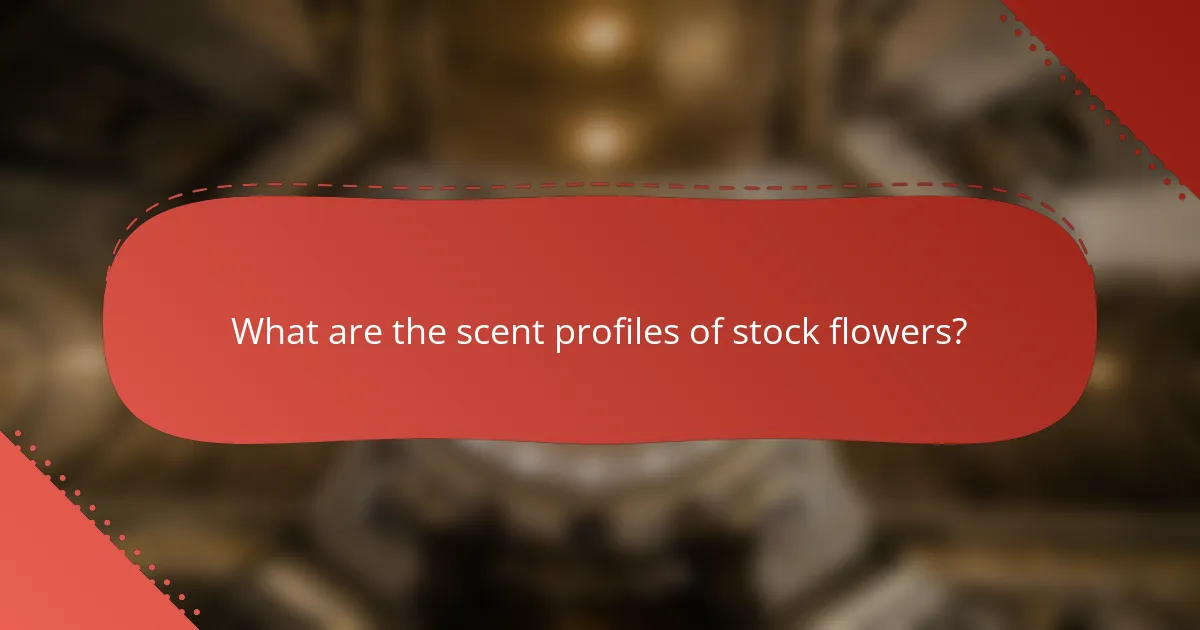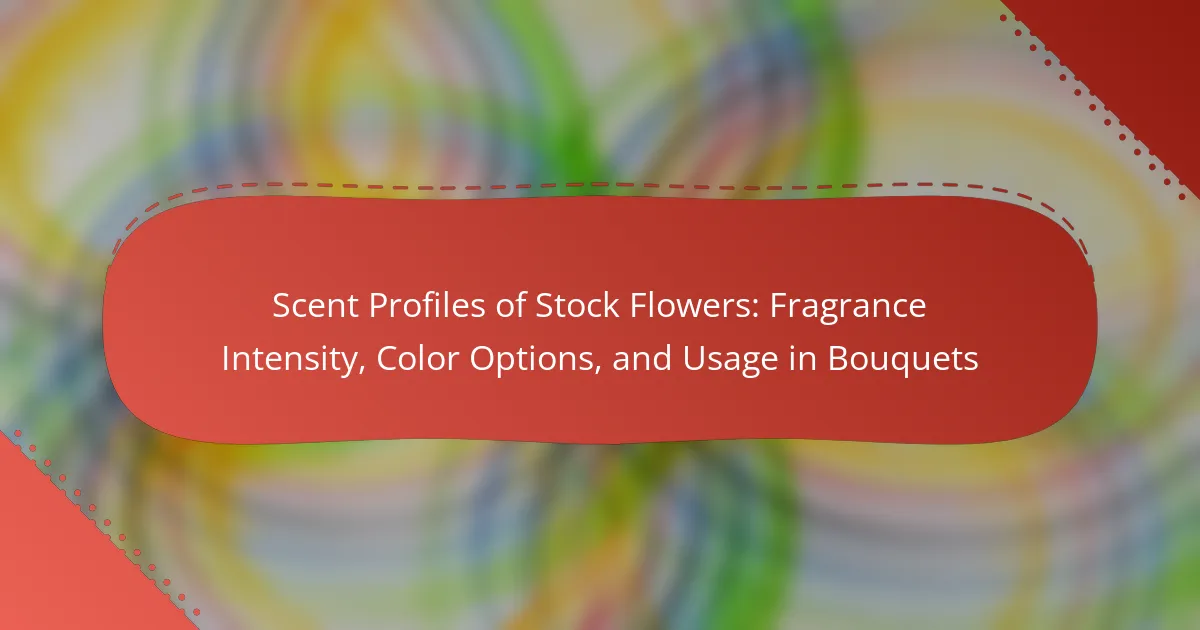
What are the scent profiles of stock flowers?
Stock flowers emit a sweet and clove-like fragrance. This scent is often described as rich and floral. The aroma is particularly strong in the evening. It attracts pollinators like bees and butterflies. Stock flowers are commonly used in gardens and floral arrangements. Their scent enhances the overall fragrance of mixed bouquets. The intensity of the fragrance can vary by color variety. White and purple stocks are noted for their stronger scents compared to other colors.
How do fragrance intensity levels vary among stock flowers?
Fragrance intensity levels among stock flowers vary significantly based on specific cultivars. Some stock flower varieties exhibit strong, sweet scents, while others have a more subtle fragrance. For example, the Matthiola incana species is known for its potent aroma. In contrast, certain hybrids may offer a lighter scent profile. Environmental factors also influence fragrance intensity. Factors such as soil quality, sunlight exposure, and watering can enhance or diminish the scent. Studies have shown that optimal growing conditions lead to higher essential oil production, which directly correlates with fragrance strength.
What factors influence the fragrance intensity of stock flowers?
The fragrance intensity of stock flowers is influenced by several key factors. These factors include genetic variation, environmental conditions, and cultivation practices. Genetic variation determines the inherent fragrance potential of different stock flower varieties. Environmental conditions such as temperature, humidity, and soil quality can enhance or diminish fragrance production. Additionally, cultivation practices like fertilization and watering influence overall plant health, which in turn affects fragrance intensity. Research indicates that optimal growing conditions can significantly enhance the aromatic compounds produced by stock flowers.
How can fragrance intensity affect the choice of stock flowers in arrangements?
Fragrance intensity significantly influences the selection of stock flowers in arrangements. Strongly scented stock flowers may dominate the overall fragrance profile of the bouquet. Florists often choose milder-scented varieties to balance the scent in mixed arrangements. For example, a highly fragrant stock can overpower delicate flowers, leading to an unbalanced aroma. Additionally, the setting of the arrangement matters; stronger scents are preferable in larger spaces. In contrast, softer scents suit intimate settings. Ultimately, the choice of stock flowers hinges on achieving a harmonious fragrance experience.
What color options are available for stock flowers?
Stock flowers are available in a variety of color options. Common colors include white, pink, lavender, and purple. Additionally, stock flowers can be found in shades of yellow and red. These colors are often used in floral arrangements and bouquets. The vibrant hues contribute to the aesthetic appeal of floral designs. Stock flowers are valued for their visual diversity.
What are the most common colors found in stock flowers?
The most common colors found in stock flowers are white, pink, purple, and yellow. White stock flowers are often used for their classic and elegant appearance. Pink varieties add a soft, romantic touch to arrangements. Purple stock flowers bring a vibrant and rich hue, making them popular in mixed bouquets. Yellow stock flowers provide a cheerful and sunny element. These colors are frequently chosen for their versatility and appeal in floral designs.
How do color variations impact the visual appeal of bouquets?
Color variations significantly enhance the visual appeal of bouquets. Different colors evoke distinct emotions and attract attention. For example, warm colors like red and orange create a sense of energy and warmth. In contrast, cool colors such as blue and green can convey calmness and serenity. The combination of contrasting colors can create visual interest and depth. Studies show that bouquets with diverse color palettes are more visually striking. This variety can lead to increased buyer interest and preference. Additionally, color variations can highlight the unique attributes of individual flowers. Overall, the strategic use of color in bouquets plays a crucial role in their aesthetic value.
How are stock flowers used in bouquets?
Stock flowers are commonly used in bouquets for their vibrant colors and pleasant fragrance. These flowers add visual appeal and a sweet scent to floral arrangements. They are often combined with other flowers to create depth and texture. Stock flowers can be used as focal points or fillers in bouquets. Their tall and sturdy stems make them suitable for various bouquet styles. They are popular in both casual and formal arrangements. Additionally, stock flowers have a long vase life, enhancing the longevity of the bouquet. Their versatility allows for use in weddings, events, and everyday floral displays.
What are the best practices for incorporating stock flowers into floral arrangements?
Incorporating stock flowers into floral arrangements requires careful consideration of their attributes. First, select stock flowers with vibrant colors that complement other blooms. Stock flowers thrive in mixed arrangements due to their height and structure. Position them toward the center or back of the arrangement for balance. Ensure they receive adequate water to maintain freshness. Pair stock flowers with complementary scents to enhance the overall fragrance profile. Additionally, consider seasonal availability to ensure quality. Stock flowers typically last well, making them reliable for longer displays. Their sweet aroma can elevate the sensory experience of the arrangement.
How do stock flowers complement other flowers in a bouquet?
Stock flowers complement other flowers in a bouquet by adding texture and fragrance. Their dense flower spikes create visual interest alongside other blooms. The sweet scent of stock flowers enhances the overall aroma of the bouquet. They come in various colors, allowing for harmonious color combinations. Stock flowers have a long vase life, contributing to the bouquet’s longevity. Their upright growth habit provides height, balancing shorter flowers. Additionally, they can fill gaps in arrangements, ensuring a fuller appearance. These attributes make stock flowers versatile companions in floral design.
How do scent profiles of stock flowers enhance bouquet experiences?
Scent profiles of stock flowers enhance bouquet experiences by providing rich and varied fragrances. The aromatic compounds in stock flowers contribute to a complex olfactory experience. This complexity can evoke emotions and memories, making bouquets more meaningful. Stock flowers typically have a sweet, clove-like scent that is appealing to many. Their fragrance can create a calming atmosphere, enhancing the overall sensory experience. Studies show that pleasant scents can improve mood and well-being. Therefore, incorporating stock flowers into bouquets not only adds beauty but also enriches emotional connections through scent.
What tips can help in selecting the right stock flowers for specific occasions?
Select stock flowers based on the occasion’s theme and color scheme. Consider the fragrance intensity; lighter scents suit intimate gatherings. For weddings, vibrant colors and strong fragrances create a festive atmosphere. Funerals typically require softer colors and subtle scents for respectfulness. Seasonal availability is also crucial; choose flowers that are in bloom during the occasion. Research shows that color psychology affects emotions; for example, red symbolizes love, while white signifies purity. Matching the flower’s scent profile with the event’s mood enhances the overall experience.
The main entity of this article is stock flowers, which are recognized for their sweet and clove-like fragrance, varying in intensity based on cultivar and environmental factors. The article explores the scent profiles of stock flowers, detailing how fragrance intensity can influence floral arrangements and the selection of colors, including white, pink, purple, and yellow. Additionally, it discusses best practices for incorporating stock flowers into bouquets, emphasizing their visual appeal, longevity, and the emotional connections evoked by their aromas. The content also highlights the impact of color variations on bouquet aesthetics and offers tips for choosing the right stock flowers for specific occasions.
